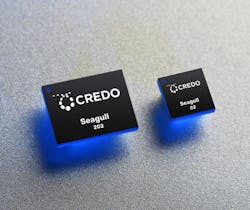Credo intros new Seagull optical DSPs with integrated DML drivers
Credo Technology Group Holding Ltd. (NASDAQ: CRDO) has unveiled a pair of optical DSPs with integrated directly modulated laser (DML) drivers. The DSPs in the single-channel Seagull 52 and the quad-channel Seagull 202 enable module designs leveraging uncooled DMLs to address applications that require industrial temperature performance, including hyperscale data centers and 5G network support.
The Seagull 52 can be used as a bitmux or retimer in QSFP28, DSFP, SFP-DD, and SFP56 optical transceivers. In bitmux mode, the DSP is configured with two lanes of 25-Gbps NRZ on the host side to one 53.125-Gbps (26.5625 GBd) PAM4 lane on the line side. In retimer mode, designers can configure the Seagull 52 as one lane of 53.125-Gbps PAM4 to one lane of 53.125-Gbps PAM4. The device also enables backwards compatibility via support of legacy data rates.
The full-duplex Seagull 202 DSP can be designed into 4x50-Gbps QSFP28 optical transceivers for high density data center networks.
In addition to enabling the use of DMLs, the DSP engine in these additions to the Seagull line enables transmission over an extended range of wavelengths. The DSPs also benefit from test and debug features for rapid turn-up, simplified lab and production testing, and reduced time to market, says the company.
The 12-nm CMOS devices leverage Credo’s proprietary approach that enables power dissipation levels associated with 7-nm chips, asserted Scott Feller, vice president of marketing at Credo. While there is significant discussion about transmission moving to 100-Gbps lanes, particularly in the data center, Feller said that 50-Gbps per lane will continue to be used in such applications. The Seagull DSPs therefore can be used for cost-reduced new generations of 50 Gbps per lane devices. The DSPs are sampling now with production in the near term, Feller added.
For related articles, visit the Optical Technologies Topic Center.
For more information on optical components and suppliers, visit the Lightwave Buyer’s Guide.
To stay abreast of optical communications technology, subscribe to Lightwave’s Enabling Technologies Newsletter.
About the Author

Stephen Hardy
Editorial Director and Associate Publisher, Lightwave
Stephen Hardy is editorial director and associate publisher of Lightwave and Broadband Technology Report, part of the Lighting & Technology Group at Endeavor Business Media. Stephen is responsible for establishing and executing editorial strategy across the both brands’ websites, email newsletters, events, and other information products. He has covered the fiber-optics space for more than 20 years, and communications and technology for more than 35 years. During his tenure, Lightwave has received awards from Folio: and the American Society of Business Press Editors (ASBPE) for editorial excellence. Prior to joining Lightwave in 1997, Stephen worked for Telecommunications magazine and the Journal of Electronic Defense.
Stephen has moderated panels at numerous events, including the Optica Executive Forum, ECOC, and SCTE Cable-Tec Expo. He also is program director for the Lightwave Innovation Reviews and the Diamond Technology Reviews.
He has written numerous articles in all aspects of optical communications and fiber-optic networks, including fiber to the home (FTTH), PON, optical components, DWDM, fiber cables, packet optical transport, optical transceivers, lasers, fiber optic testing, and more.
You can connect with Stephen on LinkedIn as well as Twitter.
